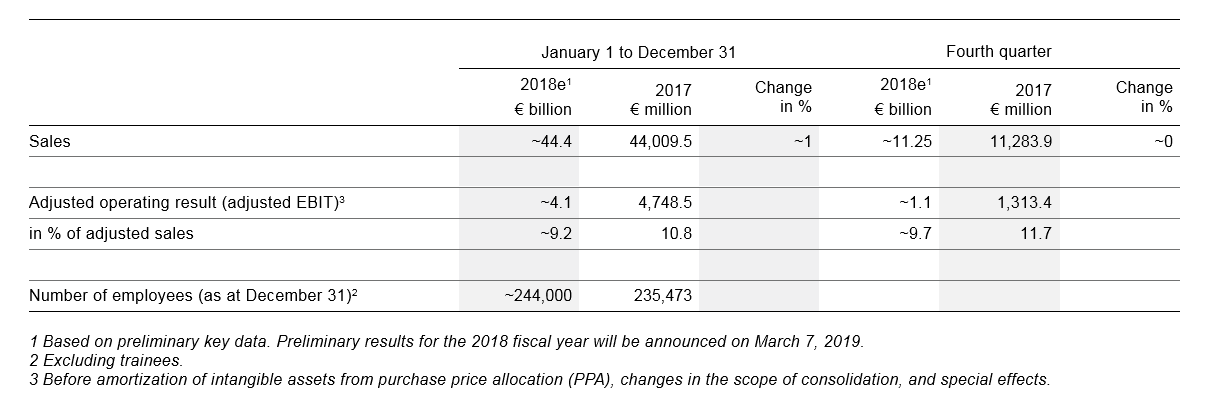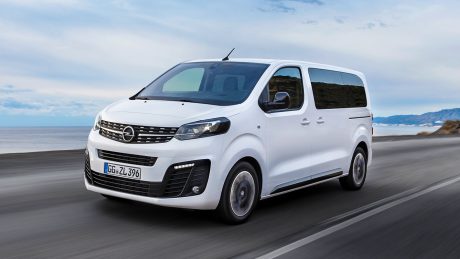The upcoming Mercedes-Benz GLB SUV will feature a pure-electric EQ B version alongside petrol, diesel and petrol-electric hybrid powertrains. The EQ B, sitting underneath the recently revealed EQ C, promises a range of up to 310 miles and will feature an aerodynamically optimised GLB-based body, according to factory insiders. The new Mercedes-Benz SUV, which goes under… Continue reading New Mercedes GLB SUV to feature all-electric EQ B version
Tag: Manufacturing
Continental Achieves Annual Targets
Stable operating performance in fourth quarter as expected Annual sales rise to around €44.4 billion (organic growth at about 3 percent) Adjusted EBIT for the year: around €4.1 billion (margin at about 9.2 percent) Free cash flow was higher than expected at about €1.8 billion 2019 outlook: Consolidated sales of about €45 to €47 billion at… Continue reading Continental Achieves Annual Targets
Tesla Supercharger V3 vs. Taycan Charging: 75D Retirement Suggests Battle Prep
Electric Cars
Electric Car Benefits
Electric Car Sales
Solar Energy Rocks
RSS
Advertise
Privacy Policy
Batteries
Published on January 14th, 2019 |
by Dr. Maximilian Holland
Tesla Supercharger V3 vs. Taycan Charging: 75D Retirement Suggests Battle Prep
Twitter
LinkedIn
Facebook
January 14th, 2019 by Dr. Maximilian Holland
With the recently announced retirement of the 75D variants of the Models S and X, and hints about upcoming v3 Superchargers, Tesla is likely getting battle prepared to match the Taycan’s real-world charging speeds (miles added per minute).
Elon Musk announced this last week that the 75D variants of the Model S and Model X are soon going to be retired from production (tomorrow or today, depending on where you are). Tesla won’t of course be leaving customers with only one battery size option (the 100 kWh battery) for long, but will likely instead introduce a new, higher capacity, “standard range” (or perhaps “mid range”) battery option for the S and X. There’s a nexus of other factors and considerations that also relate to this change, including the soon-to-arrive, faster, Supercharger v3, and the need to compete with the headline specs of other premium EVs that will be coming available — especially the Porsche Taycan and it’s fast DC charging speeds.
Why retire the 75D battery packs?
A relative weakness of the 75D’s battery has been its comparatively low DC charging speed compared to all other current Tesla batteries. Whist other current batteries can Supercharge at up to 120 kW (even that of the Model 3 Mid Range), the 75D’s batteries top out at 100 kW, and are thus below the limits of even the current Supercharger technology, let alone the upcoming v3 generation. The 75Ds have managed to maintain some pride by using their energy a bit more efficiently than their 100D (and P100D) siblings, claiming back some kudos in terms of replenishing miles per minute of charge.
Click to Embiggen
The graphs (courtesy of the gurus over at ABRP) suggest that there is still some headroom for higher powered charging in the current P/100D and Model 3 batteries (and we don’t yet have a graph for the Model 3 mid range, but it may also have some headroom).
The Model 3 Long Range’s EPA document (below) clearly states that the battery is capable of 525 amp charging (equating to around 183 kW, given the pack’s 350 volts), which is supported by Model 3 teardowns that have uncovered internal DC charge cabling capable of supporting these amp levels. This speaks volumes about the newer technology in the Model 3’s battery pack, likely enabled by some combination of cell chemistry (newer), cell geometry (21700s vs. 18650s), and cooling system design. For present purposes, it also tells us about Tesla’s Supercharging roadmap (more on this below).
At the time it first came on the market in 2016, the 75D battery pack’s DC charging was fast enough to far out-compete anything the EV competition could offer. Now the Audi e-tron is soon to be delivered, which can DC charge at 155 kW peak, and by the end of this year (or early next), the Porsche Taycan will appear, which Porsche is claiming can DC charge at something around 350 kW peak (although closer to 280 kW average, more on this below). Although the Model X75D has a longer range and is far more efficient than the e-tron, it’s charging still loses out slightly on a miles per minute basis (adding 145 EPA highway miles in 30 minutes, vs. the e-Tron’s likely 157 EPA miles, by my estimate). Likewise, the S75D will be outgunned on a miles per minute charging basis by the Taycan, despite having a greater EPA range.
What do these signs this suggest about Tesla’s steps going forwards?
It’s surely not entirely for nothing that the Model 3’s EPA document points to a charging capability of 525 amps, and the onboard cabling supports it. Tesla has evidently already prepped the Model 3 for the next evolution in Supercharging.
Allowing for a safety margin, it seems that around 500 amps may well be the target for the V3 Superchargers, up from the current maximum 330 amps. This also matches the CCS version 2.0 specifications’s maximum amperage ceiling, and we know Tesla is looking to align to some extent with the CCS standards, at least in its European market (where the e-tron and Taycan will mostly be selling). If this is correct, then what more does this entail?
The Model 3 looks set for a solid 175 kW peak Supercharging (350 volts * 500 amps). Certainly, the long-range battery should be capable of this, though the mid range and standard range may come in slightly lower (but still well above the 120 kW present ceiling).
500 amps combined with the S and X’s present 400 volt batteries should in principle allow 200 kW peak DC Supercharging. The present P/100D pack may or may not support this, but it’s certainly something we can expect from all future S and X battery packs, including whatever is released to replace the retired 75D packs.
200 kW Supercharging is already pretty good. But hold on to your hat for a minute.
The upcoming Tesla Roadster’s 200 kWh battery would still take a relatively long time to re-charge to 80% if it (and the Superchargers) are limited to 200 kW power levels — much longer than the Model 3’s ~80 kWh (gross) pack will require at 175 kW. This suggests Tesla will at some point be looking to elevate its battery pack and powertrain voltages on the Roadster.
Likewise, the upcoming Tesla pickup truck will also need a large battery, and will chew through energy more quickly than the other Teslas. It too would benefit from greater-than-200 kW charging, and thus higher battery pack voltages. The Jaguar I-PACE and Audi e-tron’s batteries have nominal voltages of 450 volts. The Taycan, 800 volts.
The downside of higher voltages is that it requires more expensive inverters and other electrical components. The plus side is that it allows better power-to-heat ratios (amongst other things). I wouldn’t be surprised if Tesla configures the Roadster’s voltage up towards 500, 600, or even 800 volts, and perhaps likewise for the pickup truck. This also suggests that some (if not all) of the v3 Superchargers will be prepped to be capable of outputting these higher voltages, even if these abilities lie dormant initially. Again, the CCS 2.0 standard can offer voltage and amperage combinations up to 1000 volts (though not simultaneously with the maximum 500 Amps). Tesla may well look to follow suit.
Another reason to expect that Supercharger v3 will be ready for higher voltages is to allow the S to compete with the Taycan. At 200 kW, even combined with the Model S’s class-leading energy efficiency, the S can’t quite match the Taycan’s recharging times in miles added per minute. Based on all that Porsche has promised, the Taycan will sustain an average charge power close to 350 kW for the first 60% of charging, then taper off considerably to give a session average 288 kW by the time 80% charge is reached. This equates to 80% charging within 15 minutes (starting from or near empty). Given the Taycan’s pack size is around 90 kWh (usable), and the range is 500 km / 310 miles (NEDC), we can do the math. The outdated NEDC range rating is usually inflated anywhere between 30% and 60% compared to the more realistic EPA ratings. Let’s speculate that the Taycan’s EPA range will be 225 miles (assuming 38% inflation). The 80% amounts to adding 180 (EPA) miles in 15 minutes.
For the current Model S100D, the EPA combined range is 335 miles (from the usable ~96 kWh pack). Although this makes the Model S some 40% more efficient than the Taycan, it also means that 15 minutes of 200 kW charging adds about 174 (EPA) miles of range, a bit short of the Taycan’s mile-per-minute rate. If, as we speculated above, the Superchargers are prepped with voltages above their present 400–410 volt ceiling, it would make sense for the S and X to also benefit from having higher voltages at some point, to keep abreast of the competition. This would likely be somewhere between 450 and 800 volts. Even at 450 volts (allowing 225 kW charging at 500 amps), the Tesla Model S would add more miles per minute than the Taycan.
Conclusions
The 75D battery pack’s retirement suggests that a new pack is on the way, with more cutting edge capabilities. In line with the company’s marketing shift for the Model 3, Tesla will likely refer to the new pack as a “Standard Range” (or “Mid Range”) battery. In the Model S, this will likely see EPA range pushed towards 300 miles (from the S75D’s 259 miles), with the usual scaling of range for the Model X. It will also be Supercharger v3 ready, so capable of peak charging of at least 200 kW (if pack voltage remains at 400 volts nominal).
Not to be outdone, the P/100D battery will also have to see an upgrade before long, perhaps towards 110–112 kWh usable (a “120D” pack), which should correspond to 400 miles of EPA range and be officially renamed “Long Range.” It will also get the new technology, and be capable of at least 200 kW charging. Both these upcoming Standard Range and Long Range packs may at some point see the voltage rise from the present 400 nominal volts to 450, 500, or more. Whether these packs will incorporate the Gigafactory’s 21700 cells (the original Tesla-Panasonic contract for 2 billion 18650 cells is reportedly close to being fulfilled) or simply newer chemistry 18650s is an interesting question, but one for another day.
We can be confident of the above 200 kW Supercharging, because we’ve seen that the Model 3’s internals and documents show it is capable of 525 amps (probably 500 amps in practice). This means the v3 Superchargers will very likely be running at 500 amps, giving the Model 3 175 kW charging (and the S and X 200 kW charging).
If the Roadster and pickup truck are to be future proofed in terms of charging speeds, Tesla may need to step up the operating voltage to 450, 500, 600, or more. If this perspective makes sense, we can expect the v3 Su..
That can count
*/ ]]> Zafira Life celebrates its world premiere on 18 January 2019 at the Brussels Motor Show, which can be ordered from February. The Zafira Life is available in three lengths: as “Small” version with 4.60 meters length, as “medium” with 4.95 meters as well as “Large” with 5.30 meters. The “S” version is almost… Continue reading That can count
Loyal trophy collector
*/ ]]> Opel endurance runner: Kai-Uwe Wehrheim drives for decades Opel. His current trophy is the Vectra C. “Instead of using a company car, I prefer to use my Vectra. I’ve been able to rely on that for years. “ – Kai-Uwe Wehrheim – owner of the kilometer hero The community Heidenrod extends in 19… Continue reading Loyal trophy collector
Latest in Ford-VW buzz: Hackett says VW might make Fords in Europe – Detroit Free Press
Detroit Free Press staff Published 9:19 p.m. ET Jan. 13, 2019 | Updated 9:50 p.m. ET Jan. 13, 2019 CLOSE Analysts note that the car companies recently initiated talks about small partnerships, but each may be motivated to think big because of their limited product lines and limited regional scope. Wochit One of the big stories at… Continue reading Latest in Ford-VW buzz: Hackett says VW might make Fords in Europe – Detroit Free Press
Taxes, work, mobility, ecological transition … The key points of Emmanuel Macron’s Letter to the French
It’s now official. Sunday, January 13, the President of the Republic laid the foundation for his “great national debate” that will run until March 15. “We will now enter a larger phase and you can participate in debates near your home or express yourself on the Internet to promote your proposals and ideas,” he said… Continue reading Taxes, work, mobility, ecological transition … The key points of Emmanuel Macron’s Letter to the French
Volkswagen may have to launch new diesel vehicle recalls in Europe
KBA, the automotive sector supervisory authority Germany, has opened an investigation to determine if a software update on cars with a 1.2-liter engine, including the popular Polo, allowed the manufacturer to cheat with emissions tests, says Bild am Sonntag, who does not quote sources. The newspaper adds that the prosecution is preparing to accuse alleged… Continue reading Volkswagen may have to launch new diesel vehicle recalls in Europe
Toyota plans to launch its version of Baleno facelift in India soon
NEW DELHI: Japanese auto major Toyota is gearing up to launch its version of Suzuki’s premium hatchback Baleno in the Indian market in the second half of next fiscal, according to sources. Toyota has been working on incorporating its own unique features to the model that has been a runaway success for Suzuki’s Indian arm… Continue reading Toyota plans to launch its version of Baleno facelift in India soon
Toyota plans to launch its version of Baleno in India next fiscal
NEW DELHI: Japanese auto major Toyota is gearing up to launch its version of Suzuki’s premium hatchback Baleno in the Indian market in the second half of next fiscal, according to sources. Toyota has been working on incorporating its own unique features to the model that has been a runaway success for Suzuki’s Indian arm… Continue reading Toyota plans to launch its version of Baleno in India next fiscal




